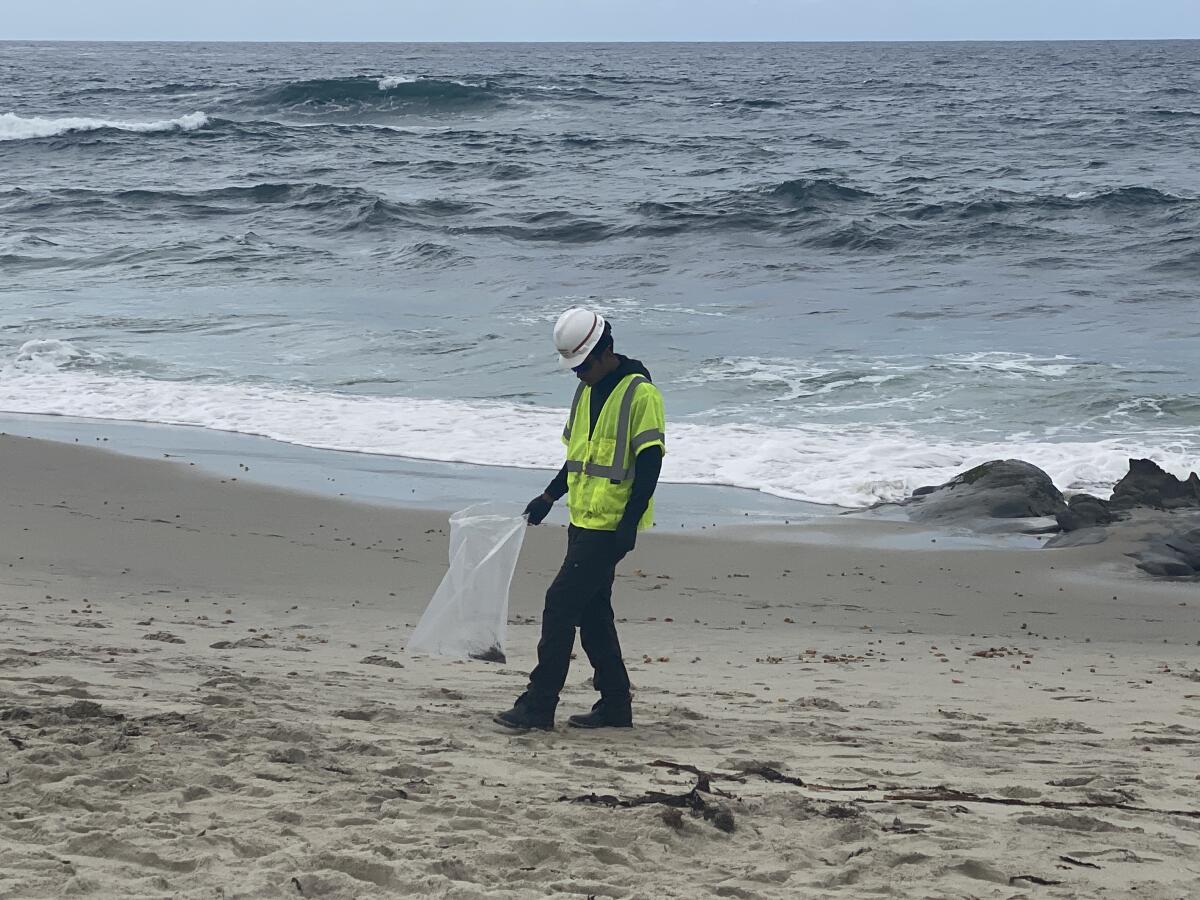Coast Guard cleans La Jolla beach after reports of tar balls linked to O.C. oil spill

A 17-person crew from the Coast Guard was seen cleaning Windansea Beach on Monday, soon after reports and photos began surfacing of tar balls on La Jolla beaches, more than two weeks after a broken pipeline spilled at least 25,000 gallons of crude oil off the Orange County coast.
“We are continuing our efforts to make sure everything is cleaned up,” Coast Guard spokesman Adam Stanton said. “More and more tar balls can come onto the beach, so we are going to try and get it entirely cleaned up.”

Stanton said the tar balls were linked to the oil spill. There was no estimated timeline for when the beach would be considered cleaned.
Local beaches remain open, and public health is not considered to be at risk. However, experts advise people who encounter tar balls not to handle them or any oil but rather to email for cleanup teams at tarballreports@wildlife.ca.gov.
In the days since the spill was first reported Oct. 2 off the coast of Huntington Beach, tar balls have been spotted as far south as Del Mar. But as of last week, UC San Diego’s Scripps Institution of Oceanography in La Jolla said it had found no evidence of oil in the waters off La Jolla through daily drone surveys and water samples.
A representative of Scripps Oceanography did not immediately respond to a request for comment Monday.
Measures at La Jolla’s Scripps Institution of Oceanography and Birch Aquarium aim to protect marine life while oceanographers assist in wind and currents forecasts.
Dr. Jyoti Mayadev, a professor at UCSD and a researcher at the university’s Moores Cancer Center, told the La Jolla Light in an email Sunday night that she had found “numerous” tar balls that evening along the beach at La Jolla Shores.
“They were everywhere,” said Mayadev, a La Jolla resident.
Resident Abraham Palmer wrote on social media the same day that “tar balls are all over Windansea Beach. Everywhere. Without even trying, I found 50 pieces. Some were as small as a penny, others 5 inches in diameter. Mostly mixed into the seaweed. All were pretty flat and super sticky.”
Marvin Liu, a resident of La Jolla’s Barber Tract neighborhood, posted that he saw a tar ball Sunday at Marine Street Beach.
Tar balls form when heavier components of an oil slick remain in the water, and winds and waves tear the slick into patches. Winds and currents can carry the balls onto beaches. Tar balls also can be produced from natural seeps, or places where oil slowly leaks out of the ground above petroleum reservoirs.
“If you step on them, they will stick to your skin,” Palmer wrote. “You’ll need to remove the tar at home; even then it’s very hard.”

According to Southern California Spill Response, this type of oil contains hazardous chemicals: “If skin contact occurs, wash the area with soap and water or baby oil. Avoid using solvents, gasoline, kerosene, diesel fuel or similar products on the skin. These products, when applied to skin, present a greater health hazard than the tar ball itself.”
San Diego Fire-Rescue Department spokeswoman Monica Munoz said city lifeguards have been given instructions on how to proceed if beachgoers contact them about tar found on the beach. The lifeguards will notify county officials to collect the tar, she said.
More to Read
Start your day right
Sign up for Essential California for news, features and recommendations from the L.A. Times and beyond in your inbox six days a week.
You may occasionally receive promotional content from the Los Angeles Times.









